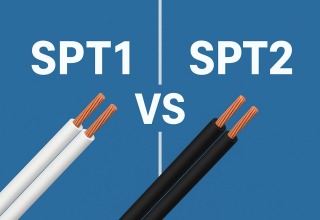
When working with lighting projects, low-voltage systems, or household extension applications, choosing the right electrical wire is crucial for safety and performance. In the world of flexible lighting cords, the two most common cable types are SPT1 and SPT2 wires.
Although they look almost identical on the outside, their performance, insulation thickness, and recommended use cases are very different. Understanding spt1 vs spt2 is essential for homeowners, DIY enthusiasts, electricians, and lighting installers.
Whether you’re wiring Christmas lights, landscape lighting, pendant lamps, or power cords for appliances, choosing between SPT1 and SPT2 will determine how safe and reliable your setup is.
🧾 What is SPT Wire?
SPT stands for Service Parallel Thermoplastic. It is a style of two-conductor flexible cord widely used for:
- Indoor lamps
- Plug-in lighting fixtures
- Extension cords
- Low-voltage LED lighting
- Holiday and Christmas lights
- DIY electrical projects
- Power supply cords for small appliances
SPT wire consists of:
- Two parallel copper conductors
- Thermoplastic insulation
- Flexible design for easy routing and installation
✅ What is SPT1 Wire?
SPT1 wire is a lightweight lamp wire built with thinner insulation.
Features of SPT1 Wire
| Specification | Details |
|---|---|
| Insulation Thickness | ~0.03 inches (0.76 mm) |
| Conductors | 2 parallel copper wires |
| Voltage Rating | Typically 300V |
| Common Gauges | 16 AWG (most common), 18 AWG |
| Flexibility | Very flexible |
| Indoor/Outdoor | Indoor (light outdoor use possible if protected) |
SPT1 is the standard household lamp cord option.
✅ When to Use SPT1 Wire
SPT1 is ideal for:
- Indoor lamps and lighting
- String lights with low heat output
- Short-run low-voltage lighting
- Temporary holiday lighting
- Plug-in LED fixtures
- Craft and DIY lighting projects
If you need a flexible, easy-to-work-with wire for everyday lamps, SPT1 is the right choice.
✅ What is SPT2 Wire?
SPT2 wire has thicker insulation designed for higher load and tougher environments.
Features of SPT2 Wire
| Specification | Details |
|---|---|
| Insulation Thickness | ~0.045 inches (1.14 mm) |
| Conductors | 2 parallel copper wires |
| Voltage Rating | Typically 300V |
| Common Gauges | 16 AWG (most common), 18 AWG |
| Flexibility | Slightly stiffer than SPT1 |
| Indoor/Outdoor | Indoor & outdoor rated |
The thicker jacket helps protect against:
- UV exposure
- Moisture
- Abrasion
- Temperature fluctuations
This makes SPT2 better for permanent outdoor installations.
✅ When to Use SPT2 Wire
SPT2 is best for:
- Permanent outdoor lighting
- Outdoor Christmas displays
- Landscape and tree lighting
- Long-run LED systems
- High-duty usage where cord will be handled frequently
- Environments with sunlight and moisture
If durability and weather-resistance matter, SPT2 is the superior option.
SPT1 vs SPT2 Wire: Key Differences
| Feature | SPT1 | SPT2 |
|---|---|---|
| Insulation Thickness | ~0.03″ | ~0.045″ |
| Heat Resistance | Standard | Higher |
| Weather Durability | Basic | Better outdoor performance |
| Flexibility | More flexible | Slightly stiffer |
| Weight | Lighter | Heavier |
| Cost | Less expensive | More expensive |
| Ideal Use | Indoor, temporary outdoor | Permanent outdoor installs |
Quick takeaway
- SPT1 = indoor, temporary outdoor, lightweight wiring
- SPT2 = outdoor, durable, long-term installations
Does SPT1 Carry Less Power than SPT2?
No.
The copper conductor inside can be identical in both SPT1 and SPT2.
The difference between SPT1 vs SPT2 is insulation thickness, not power capacity.
What determines power capacity?
- Wire gauge (AWG) – read more
- Type of copper conductor
- Length of the run
- Voltage drop
16-gauge SPT1 and 16-gauge SPT2 have the same electrical capacity — but SPT2 has better environmental protection.
Wire Gauge and SPT Ratings
Most common gauge for both is:
| Gauge | Typical Use |
|---|---|
| 18 AWG | Short runs, low-power lighting |
| 16 AWG | Standard lamp cord, LED systems |
| 14 AWG | High power holiday displays (rare for SPT cords) |
If you need long cable runs, thicker gauge wire helps reduce voltage drop.
Voltage & Amp Ratings
Typical ratings:
- 300 Volt max
- 7–10 amps, depending on gauge & jacket
Always check manufacturer specifications — but SPT1 and SPT2 usually match in electrical capacity.
Which Is Better for Christmas Lights?
| Type | Recommendation |
|---|---|
| Temporary holiday lights | SPT1 |
| Permanent holiday displays | SPT2 |
| Rooflines in winter conditions | SPT2 |
| DIY plug cords w/ vampire plugs | Both — matched plugs required |
Vampire Plugs & SPT Wire
Vampire plugs pierce insulation to create terminals.
They must match insulation thickness:
| Plug Type | Wire Compatibility |
|---|---|
| SPT1 Plug | SPT1 wire only |
| SPT2 Plug | SPT2 wire only |
Using a mismatched plug may cause:
- Poor connection
- Overheating
- Fire hazard
Safety Considerations
Always:
✅ Use matched SPT plugs
✅ Follow load calculations
✅ Avoid running wire under rugs or insulation
✅ Keep connectors dry outdoors
✅ Inspect for cracks or cuts
Never:
❌ Use SPT1 outdoors long-term
❌ Overload wire capacity
❌ Mix mismatched SPT plugs and wire
❌ Bury SPT wire directly in soil (not rated)
For burial lighting, use UF-B or direct burial low-voltage cable instead.
SPT Wire vs Other Wire Types
SPT vs SOOW Cord
| Feature | SPT Wire | SOOW Cord |
|---|---|---|
| Flexibility | High | Very high |
| Durability | Moderate | Extreme |
| Outdoor Rating | Good (SPT2) | Excellent |
| Water/oil resistance | Limited | Excellent |
SOOW is for industrial, SPT for household & lighting.
SPT vs SJTW Extension Cord
SJTW is thicker, grounded, better for power tools.
SPT is for lighting & lighter loads.
Choosing the Right Wire: Simple Guide
| Application | Best Wire |
|---|---|
| Indoor household lamps | SPT1 |
| Indoor LED lighting | SPT1 |
| Seasonal outdoor lights | SPT1 or SPT2 |
| Permanent outdoor displays | SPT2 |
| Landscape lighting | SPT2 or LV landscape cable |
| Low-voltage transformer systems | 16 AWG recommended |
Pros & Cons at a Glance
SPT1 Pros
- Affordable
- Lightweight
- Flexible
- Great for indoor use
SPT1 Cons
- Not ideal for long-term outdoor exposure
SPT2 Pros
- Thick insulation
- UV/weather protection
- Best for outdoor lighting
SPT2 Cons
- More expensive
- Slightly stiffer
Final Verdict: SPT1 vs SPT2
For indoor lighting or seasonal installs:
✅ SPT1 is typically sufficient
For outdoor lighting or permanent setups:
✅ SPT2 is the safer and more durable choice
Summary Table
| Category | SPT1 | SPT2 |
|---|---|---|
| Use | Indoor / temporary outdoor | Outdoor / permanent |
| Insulation | Thin | Thick |
| Durability | Standard | High |
| Cost | Lower | Higher |
| Best For | Lamps, Christmas lights | Landscape & outdoor lighting |
Conclusion
Choosing the right cord between SPT1 vs SPT2 comes down to insulation thickness and durability. Both wire types can carry similar electrical loads, but SPT2 has thicker insulation, making it the preferred choice for outdoor and long-term installations.
Proper matching with vampire plugs, correct gauge selection, and safe installation practices are key to reliable and safe electrical setups.
Whether you’re wiring Christmas displays, designing a lighting system, or working on home improvement projects, the right SPT wire ensures longevity, safety, and professional results.






















